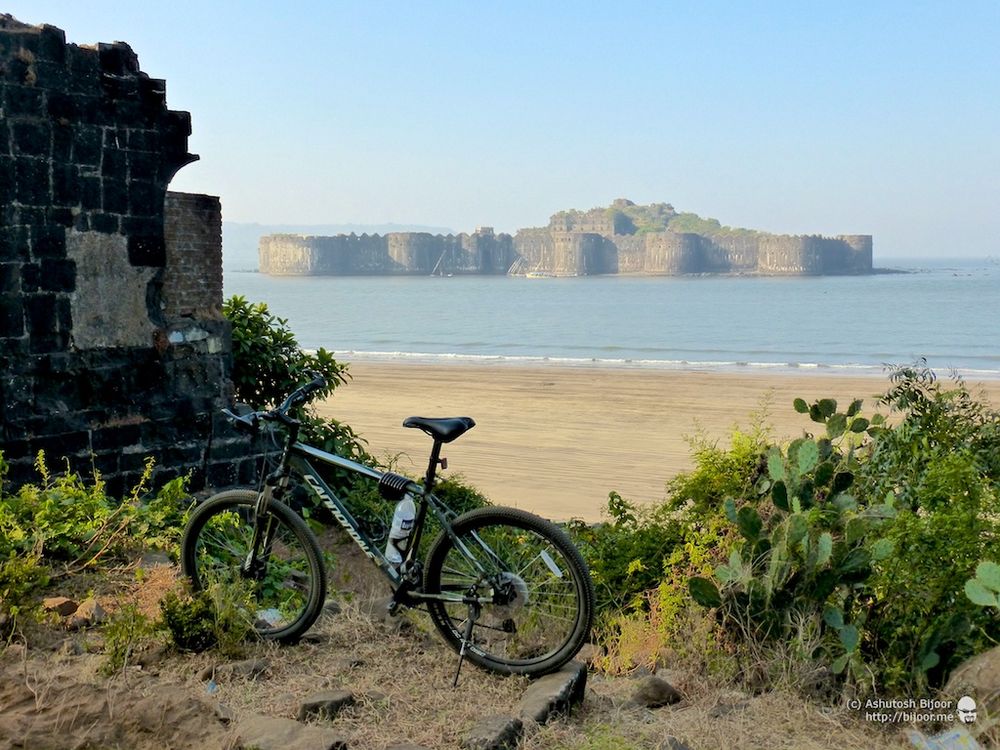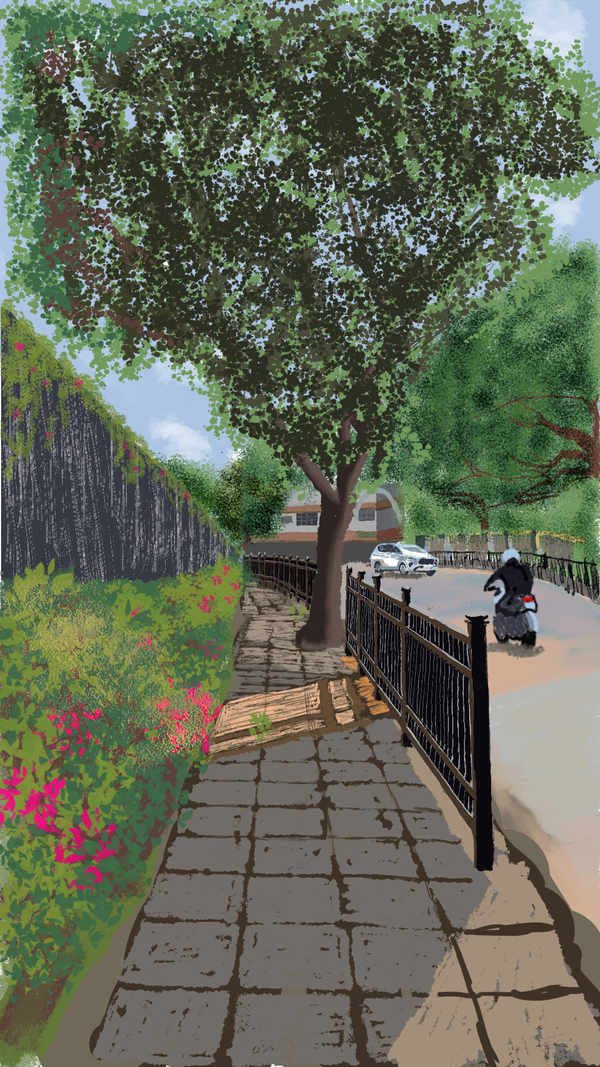Cycling from Mandwa to Murud - Janjira Fort and Khokari Tombs
Ever since I cycled to Korlai fort along the Konkan coast from Mandwa, I had wanted to continue along the same route south to the next big fort near Murud – Janjira fort – the Siddi stronghold. It is just 30 km south from Korlai fort, and at a total distance of 71 km from Mandwa. I did a two day ride with an overnight stay at Murud, giving me enough time to explore all the historical sites around Murud.
Map showing all the historical sites around Murud
 I started from Andheri on Saturday afternoon just before 3 pm and cycled to Gateway of India to catch the 4:30 pm ferry across to Mandwa jetty. Passed Oval maidan and saw the Rajabai tower under renovation
I started from Andheri on Saturday afternoon just before 3 pm and cycled to Gateway of India to catch the 4:30 pm ferry across to Mandwa jetty. Passed Oval maidan and saw the Rajabai tower under renovation
 Ferries from Gateway of India allow cycles to be boarded – but not motor cycles – for that you need to go to Bhaucha Dhakka. The fare was 85 INR and they took another 100 INR for the cycle
Ferries from Gateway of India allow cycles to be boarded – but not motor cycles – for that you need to go to Bhaucha Dhakka. The fare was 85 INR and they took another 100 INR for the cycle
 The ferry ride took an hour and a half, and by the time we arrived at Mandwa, the sun was already ready to set close to the horizon. Luckily I was prepared to ride in the dark with a good head lamp and flashing tail light. I covered the distance from Mandwa to Murud – 66 km in just under 3 hours with a couple of short halts for drinks
The ferry ride took an hour and a half, and by the time we arrived at Mandwa, the sun was already ready to set close to the horizon. Luckily I was prepared to ride in the dark with a good head lamp and flashing tail light. I covered the distance from Mandwa to Murud – 66 km in just under 3 hours with a couple of short halts for drinks
 When I reached Murud just after 9:30 pm, I headed straight to the beach front and to Patil Khanawal, the “world” famous eatery with amazing coastal cuisine. I got myself a simple yet clean room in the neighboring Murud Plaza and locked my cycle to a pillar in the basement. This photo was taken in the morning as I set out towards Janjira fort
When I reached Murud just after 9:30 pm, I headed straight to the beach front and to Patil Khanawal, the “world” famous eatery with amazing coastal cuisine. I got myself a simple yet clean room in the neighboring Murud Plaza and locked my cycle to a pillar in the basement. This photo was taken in the morning as I set out towards Janjira fort
 As you exit Murud town, a small bridge across the creek provides an excellent view of the fishing boats moored for the night, and the hills to the east waiting to greet the rising sun
As you exit Murud town, a small bridge across the creek provides an excellent view of the fishing boats moored for the night, and the hills to the east waiting to greet the rising sun
 Janjira fort is on an island just off the coast near Rajapuri, about 5 km south of Murud and lying in the cove surrounded by a small hill range. The road climbs up the range and provides the first view of the fort island out in the sea, and Rajapuri down below. The downhill ride to Rajapuri is a fitting reward after the uphill climb
Janjira fort is on an island just off the coast near Rajapuri, about 5 km south of Murud and lying in the cove surrounded by a small hill range. The road climbs up the range and provides the first view of the fort island out in the sea, and Rajapuri down below. The downhill ride to Rajapuri is a fitting reward after the uphill climb
 As I entered Rajapuri, the small fishing village was still fast asleep with the gaily painted houses lining the small street that leads to the pier. Janjira was considered to be one of the strongest marine forts in India
As I entered Rajapuri, the small fishing village was still fast asleep with the gaily painted houses lining the small street that leads to the pier. Janjira was considered to be one of the strongest marine forts in India
 When I reached the pier, I was regaled by this amazing view of the sunrise across the bay with the silhouettes of the fishing boats making many pretty pictures that consumed several Gb of my camera space
When I reached the pier, I was regaled by this amazing view of the sunrise across the bay with the silhouettes of the fishing boats making many pretty pictures that consumed several Gb of my camera space
 To the west from the pier, the fort stood imposingly in the water that was now calm and welcoming, unlike in the monsoon when the sea is so rough, that waves reach all the way to the top of the 40 feet high fort walls
To the west from the pier, the fort stood imposingly in the water that was now calm and welcoming, unlike in the monsoon when the sea is so rough, that waves reach all the way to the top of the 40 feet high fort walls
 For I was the first visitor, the boats had not yet started. Not wanting to wait for the crowds, I got a full boat by paying 600 INR – a discounted weekend price – and soon had Shoeb, the boatsman and guide combined – climb up the mast to unfurl the sail
For I was the first visitor, the boats had not yet started. Not wanting to wait for the crowds, I got a full boat by paying 600 INR – a discounted weekend price – and soon had Shoeb, the boatsman and guide combined – climb up the mast to unfurl the sail
 A short ride got us over to the fort, where I clambered across to the steps that lead up into the fort. Shoeb tells me that the fort walls are built in several layers so that it can withstand the extremely rough seas – and that the entire length of the wall is still standing tall till today
A short ride got us over to the fort, where I clambered across to the steps that lead up into the fort. Shoeb tells me that the fort walls are built in several layers so that it can withstand the extremely rough seas – and that the entire length of the wall is still standing tall till today
 I agreed to pay Shoeb 400 INR to show me around in the fort and tell me the stories that he knew about it. He gladly agreed, and patiently took me around while I gawked at everything and took photographs
I agreed to pay Shoeb 400 INR to show me around in the fort and tell me the stories that he knew about it. He gladly agreed, and patiently took me around while I gawked at everything and took photographs
 Near the entrance to the fort, this seal carved on the wall depicts six elephants being attacked by a single tiger, representing the might of the Siddi warriors that built this fort
Near the entrance to the fort, this seal carved on the wall depicts six elephants being attacked by a single tiger, representing the might of the Siddi warriors that built this fort
 As you enter from the main entrance into a foyer, you can see the tomb of Panch Peer Panjatan Shah Baba and the arched gateway leading to the inside of the 22 acre fort. The fort was initially a wooden structure called Medhekot, built by the leader of the local fishermen Ram Patil. It was later captured by the Siddi commander Piram Khan under orders of the Nizam of Ahmednagar and replaced by a stone structure. Later, it was rebuilt into a much stronger structure by Burhan Khan between the years 1567 and 1571
As you enter from the main entrance into a foyer, you can see the tomb of Panch Peer Panjatan Shah Baba and the arched gateway leading to the inside of the 22 acre fort. The fort was initially a wooden structure called Medhekot, built by the leader of the local fishermen Ram Patil. It was later captured by the Siddi commander Piram Khan under orders of the Nizam of Ahmednagar and replaced by a stone structure. Later, it was rebuilt into a much stronger structure by Burhan Khan between the years 1567 and 1571
 Adjoining the tomb on the right is another small entrance that leads up to stairs for climbing up onto the ramparts
Adjoining the tomb on the right is another small entrance that leads up to stairs for climbing up onto the ramparts
 Just above this small arch is a symbol of a lion that is filled in with writing of a verse of the Holy Quran, and the word “panja” or paw written above, after which the Panjatan Shah Baba was named
Just above this small arch is a symbol of a lion that is filled in with writing of a verse of the Holy Quran, and the word “panja” or paw written above, after which the Panjatan Shah Baba was named
 On the rampart lies the famous Kalal Bangadi – a 22 ton heavy cannon with a range of 12 km. Legend has it that the metal rings were imported from Africa and sealed together using lead. This is supposed to be the third largest cannon in India after the one in Jaigarh and Bijapur. The cannon was used to destroy the sea fort Padmadurg built by Sambhaji that is 8 km away, off the coast of Murud. Shoeb claims that the clearly visible split of Padmadurg into three parts as a result of this bombing that laid Sambhaji’s plans of taking over Janjira fort to naught
On the rampart lies the famous Kalal Bangadi – a 22 ton heavy cannon with a range of 12 km. Legend has it that the metal rings were imported from Africa and sealed together using lead. This is supposed to be the third largest cannon in India after the one in Jaigarh and Bijapur. The cannon was used to destroy the sea fort Padmadurg built by Sambhaji that is 8 km away, off the coast of Murud. Shoeb claims that the clearly visible split of Padmadurg into three parts as a result of this bombing that laid Sambhaji’s plans of taking over Janjira fort to naught
 We then walked along the ramparts towards the first bastion. There are 19 bastions spread all around the fort, with over 300 windows in them, each of which used to have a cannon
We then walked along the ramparts towards the first bastion. There are 19 bastions spread all around the fort, with over 300 windows in them, each of which used to have a cannon
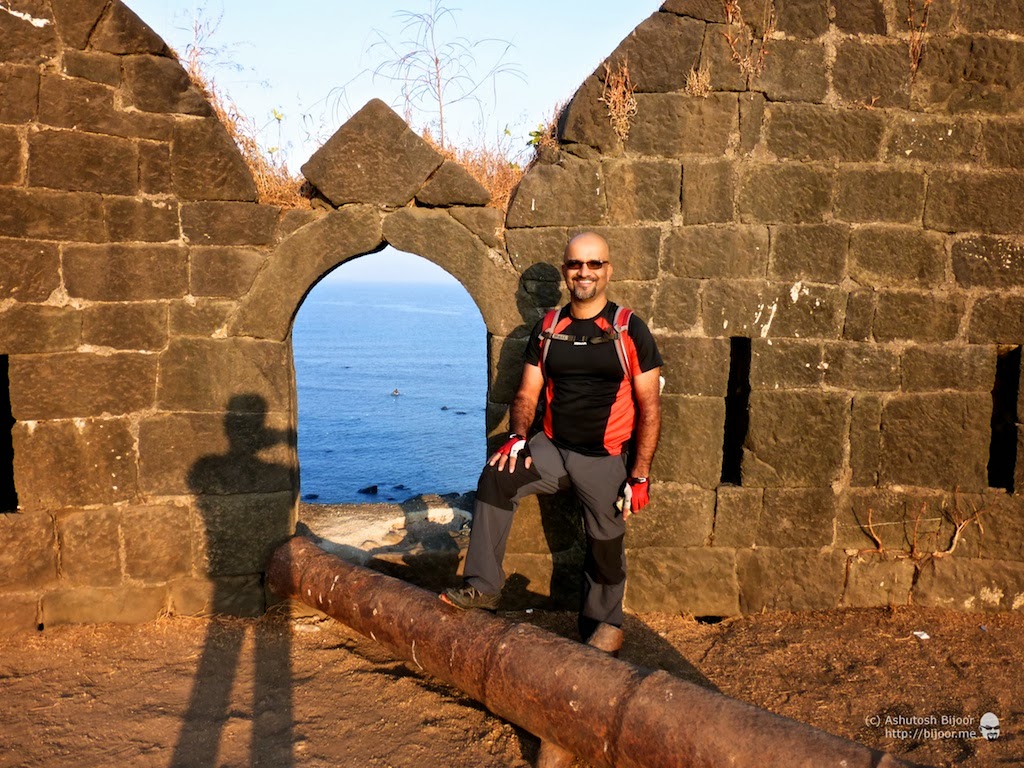 Most of the cannons have been stolen and only a few remain strewn around, providing photo opportunities for tourists. With appropriate clothing, I probably would have resembled one of the Siddi generals though falling sort of a few feet in height – for they were supposed to be tall and well built warriors
Most of the cannons have been stolen and only a few remain strewn around, providing photo opportunities for tourists. With appropriate clothing, I probably would have resembled one of the Siddi generals though falling sort of a few feet in height – for they were supposed to be tall and well built warriors
 We then climbed down one level into a hidden chamber inside the bastion with arched pillars and windows that are invisible from the outside and helped keep a watch on any possible intruders
We then climbed down one level into a hidden chamber inside the bastion with arched pillars and windows that are invisible from the outside and helped keep a watch on any possible intruders
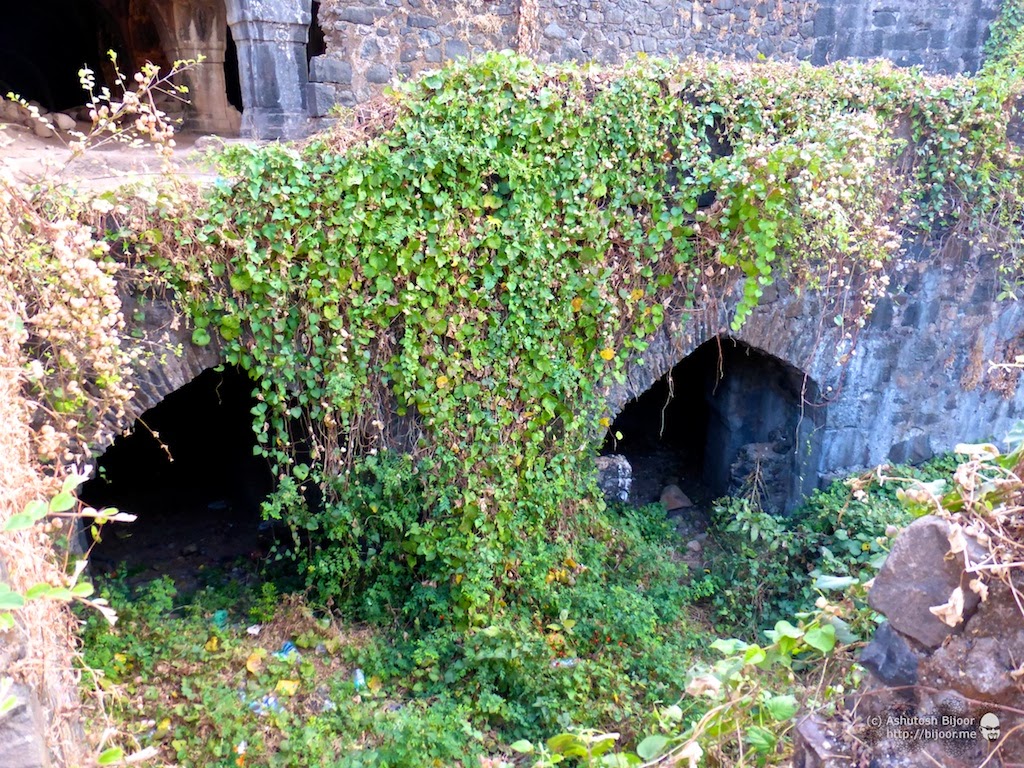 At the bottom of the bastion, under the arched chamber was an under-sea tunnel that led from the fort up to the palace on the shore. This is still in existence and was usable till a few years back but is now blocked by the Archeological Soceity of India to prevent any untoward mishap lest the tunnel collapse due to weakening walls
At the bottom of the bastion, under the arched chamber was an under-sea tunnel that led from the fort up to the palace on the shore. This is still in existence and was usable till a few years back but is now blocked by the Archeological Soceity of India to prevent any untoward mishap lest the tunnel collapse due to weakening walls
 We then headed to the buildings inside the fort, dominated by the massive palace in the center, with two lakes on either side. On the right, the white structure peering into the picture is a school and the ruins in the foreground were all residential quarters
We then headed to the buildings inside the fort, dominated by the massive palace in the center, with two lakes on either side. On the right, the white structure peering into the picture is a school and the ruins in the foreground were all residential quarters
 The Shahi lake on the right of the palace is the larger of the two, and was surrounded by a glass palace or “sheesh mahal” where the queen and her attendants used to spend leisurely mornings bathing in the cool water fed by underground springs. The lake now bears witness to the uncultured ways of visitors who have mercilessly left their droppings of plastic bottles and garbage in the water
The Shahi lake on the right of the palace is the larger of the two, and was surrounded by a glass palace or “sheesh mahal” where the queen and her attendants used to spend leisurely mornings bathing in the cool water fed by underground springs. The lake now bears witness to the uncultured ways of visitors who have mercilessly left their droppings of plastic bottles and garbage in the water
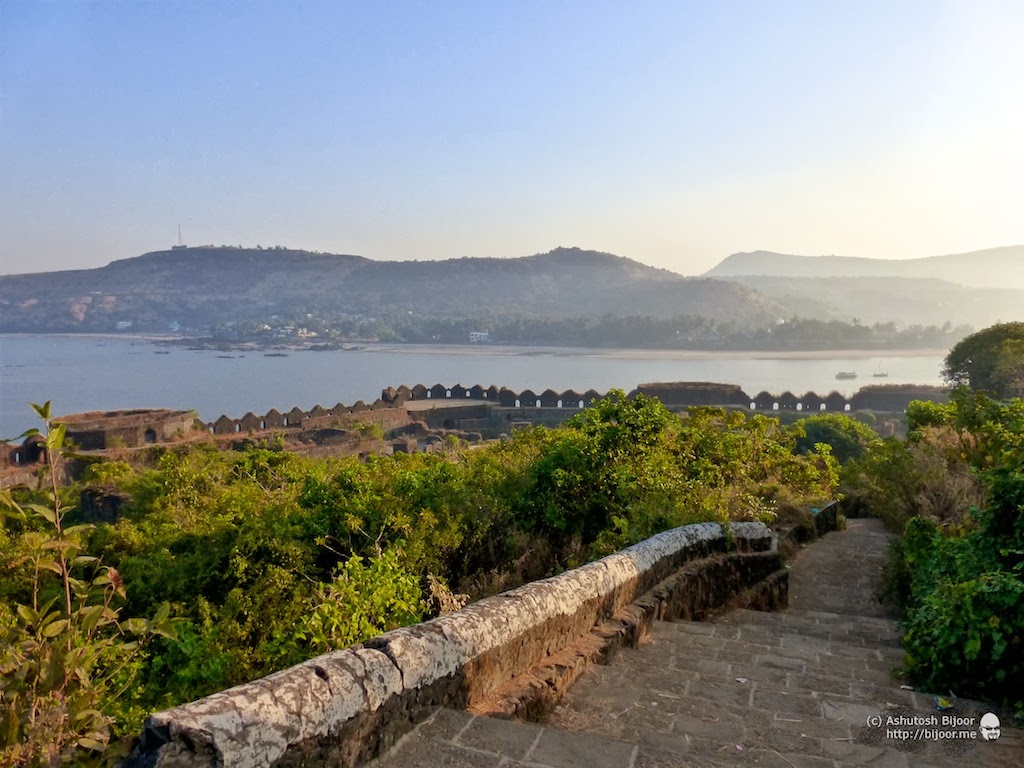 From behind the lake is a flight of stairs that leads up to the “bale killa” – the highest point in the fort with the flag post and a panoramic view of the fort
From behind the lake is a flight of stairs that leads up to the “bale killa” – the highest point in the fort with the flag post and a panoramic view of the fort
 A panoramic view of the fort from the top shows why this fort must have been such a strategic location to protect the important port of Janjira, and why the Siddis managed to fend off several attacks by various armies
A panoramic view of the fort from the top shows why this fort must have been such a strategic location to protect the important port of Janjira, and why the Siddis managed to fend off several attacks by various armies
 As we climbed down and passed the palace, Shoeb told me that this was once a seven storey structure with glass windows that shone in the night from the light of the “mashaal” or torches that were lit inside. Now only three storeys remain and those too are fast disintegrating due to the overgrowth and lack of maintenance
As we climbed down and passed the palace, Shoeb told me that this was once a seven storey structure with glass windows that shone in the night from the light of the “mashaal” or torches that were lit inside. Now only three storeys remain and those too are fast disintegrating due to the overgrowth and lack of maintenance
 On the left of the palace is the smaller of the two lakes – the Chirekhani lake next to which is the main mosque in the fort. This is now kept locked to protect it from disrespectful visitors and only opened on special festive occasions
On the left of the palace is the smaller of the two lakes – the Chirekhani lake next to which is the main mosque in the fort. This is now kept locked to protect it from disrespectful visitors and only opened on special festive occasions
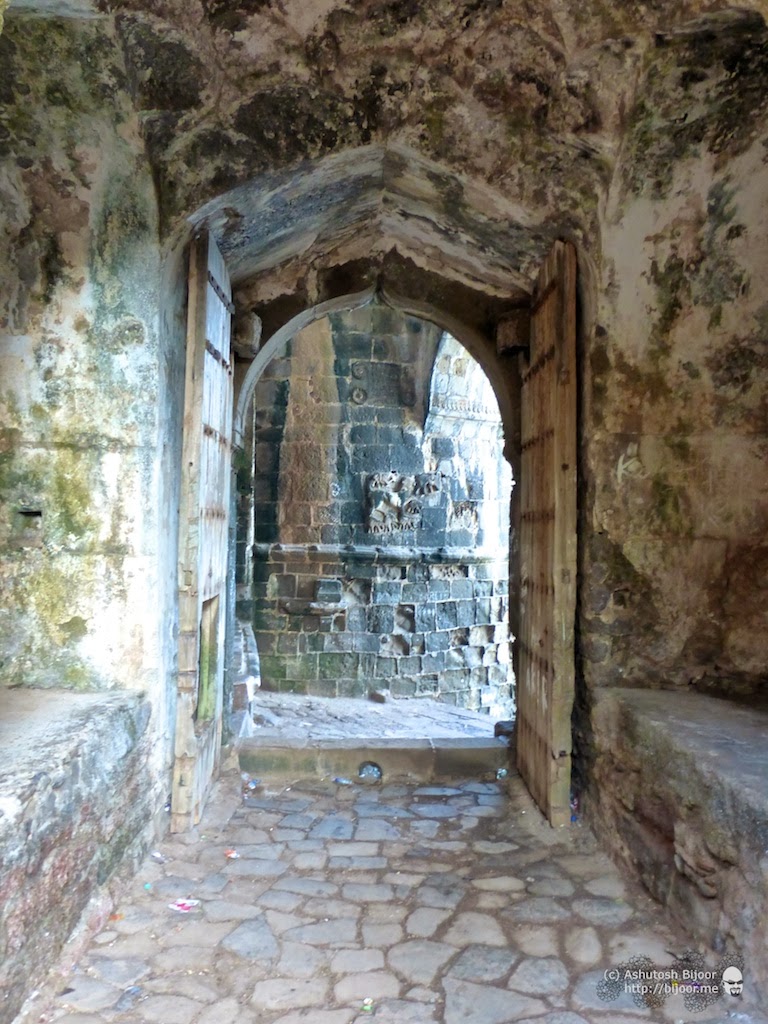 After seeing all the important structures in the fort, we headed back the the entrance towards our waiting boat. Shoeb had done a fabulous job of telling me the stories of the might of the Siddis and their stronghold fort. I still had a long way to ride back to Mumbai and so I hurried back to the boat
After seeing all the important structures in the fort, we headed back the the entrance towards our waiting boat. Shoeb had done a fabulous job of telling me the stories of the might of the Siddis and their stronghold fort. I still had a long way to ride back to Mumbai and so I hurried back to the boat
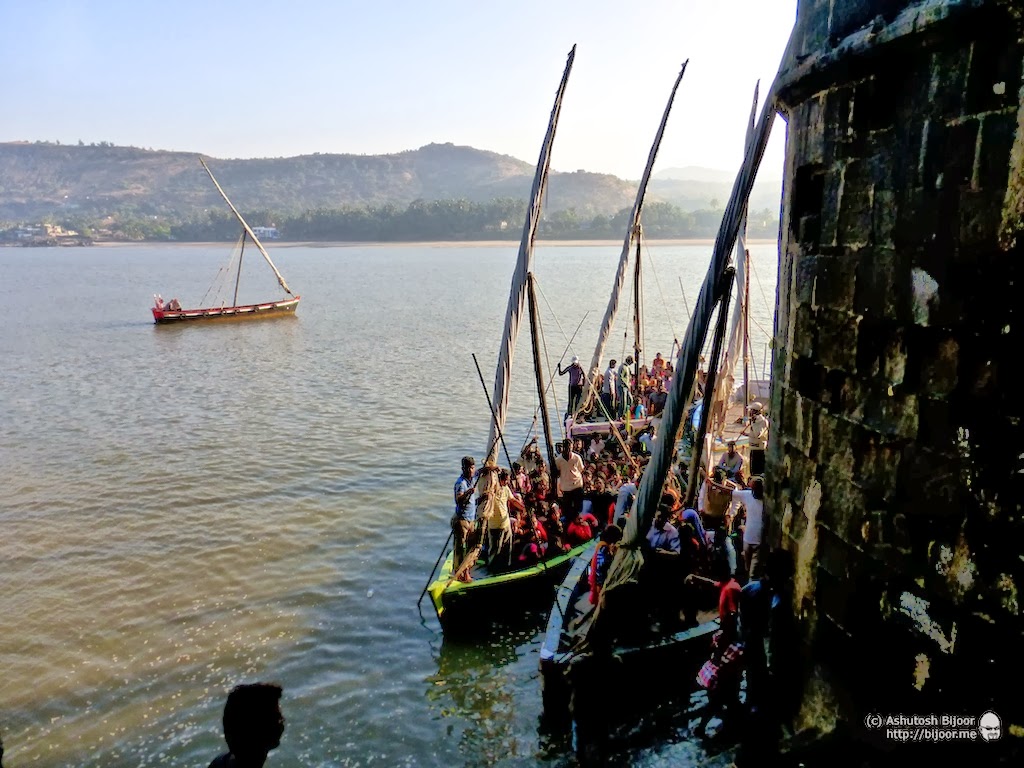 We left just in time, for a whole horde of noisy school children arrived in three boats. I hoped against hope that their teachers would be civil enough to make sure that they did not further desecrate the fort.
We left just in time, for a whole horde of noisy school children arrived in three boats. I hoped against hope that their teachers would be civil enough to make sure that they did not further desecrate the fort.
 When I returned back to the shore, I visited the palace in the village that had the other end of the under-sea tunnel. But the gates were locked so I had to contend myself by this amazing view of the fort from beside the palace
When I returned back to the shore, I visited the palace in the village that had the other end of the under-sea tunnel. But the gates were locked so I had to contend myself by this amazing view of the fort from beside the palace
 The next destination was the Khokhari tombs that lie along the coast about a kilometer south from Rajapuri. After you cross Janjira beach, the road climbs uphill again from where I got another point of view of Rajapuri and the fort behind. You have to keep riding uphill till you reach a T junction, and the tombs are to the left of the junction
The next destination was the Khokhari tombs that lie along the coast about a kilometer south from Rajapuri. After you cross Janjira beach, the road climbs uphill again from where I got another point of view of Rajapuri and the fort behind. You have to keep riding uphill till you reach a T junction, and the tombs are to the left of the junction
 The Khokari tombs are three massive stone tombs. This is the largest of the tombs of Siddi Surul Khan, who was the chief of Janjira from 1707 to 1734 and was built during his lifetime.
The Khokari tombs are three massive stone tombs. This is the largest of the tombs of Siddi Surul Khan, who was the chief of Janjira from 1707 to 1734 and was built during his lifetime.
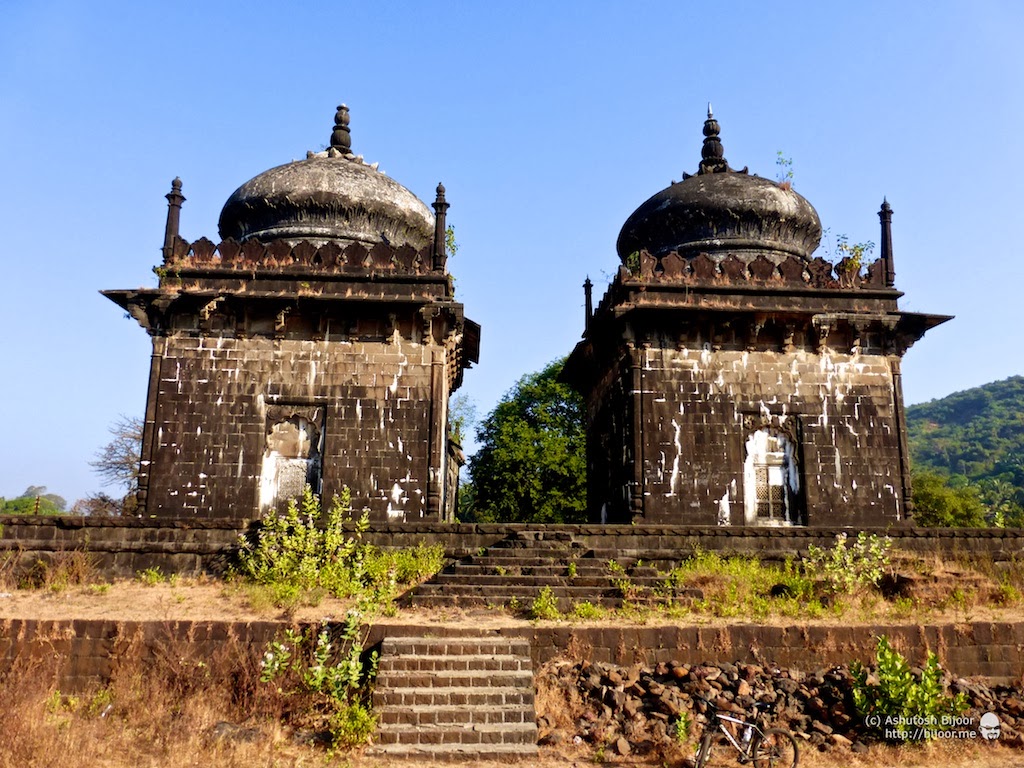 There are two smaller tombs to the right of the large one. Of these, one belongs to Khairiyat Khan, who was commander of Janjira from 1677 to 1696. The other tomb belongs to his brother Siddi Kasim also known as Yakut Khan, who was commander of Janjira from 1696 to 1707
There are two smaller tombs to the right of the large one. Of these, one belongs to Khairiyat Khan, who was commander of Janjira from 1677 to 1696. The other tomb belongs to his brother Siddi Kasim also known as Yakut Khan, who was commander of Janjira from 1696 to 1707
 This architecture style is called Indo-Saracenic, a confluence of Indian architecture found in Rajasthani temples with the ideas brought in by Turkish invaders such as arches and beams – that eventually evolved into the Mughal style
This architecture style is called Indo-Saracenic, a confluence of Indian architecture found in Rajasthani temples with the ideas brought in by Turkish invaders such as arches and beams – that eventually evolved into the Mughal style
 After visiting the Khokari tombs, I took the road towards Khar Amboli that goes all around the creek back to Murud. From Murud I climbed up the slope towards Nandgaon, I got a glimpse of the Padmadurg fort that lies 2 km into the sea built by Sambhaji
After visiting the Khokari tombs, I took the road towards Khar Amboli that goes all around the creek back to Murud. From Murud I climbed up the slope towards Nandgaon, I got a glimpse of the Padmadurg fort that lies 2 km into the sea built by Sambhaji
 At the top of the hill is the Nawab’s Palace, a private property that is not accessible to the public. The gates are occasionally opened for locals to visit the Masjid inside. I managed to poke my camera through the gate to take this photograph
At the top of the hill is the Nawab’s Palace, a private property that is not accessible to the public. The gates are occasionally opened for locals to visit the Masjid inside. I managed to poke my camera through the gate to take this photograph
 Just north of Murud is Nandgaon, and a much better place to enjoy the beach without the crowds and littering that Murud suffers from. Nandgaon beach is also a venue for bullock cart races.
Just north of Murud is Nandgaon, and a much better place to enjoy the beach without the crowds and littering that Murud suffers from. Nandgaon beach is also a venue for bullock cart races.
 Next stop was at Kashid beach for yummy breakfast of kanda poha and chai. The beach itself was full of visitors from the city, and with the trappings of tourism including speed boats and para-sailing keeping the crowds busy
Next stop was at Kashid beach for yummy breakfast of kanda poha and chai. The beach itself was full of visitors from the city, and with the trappings of tourism including speed boats and para-sailing keeping the crowds busy
 After Kashid, I passed by Korlai fort and Revdanda before entering Chaul – the erstwhile headquarters of the Portuguese. I got a glimpse of the Rameshwar Temple built by Kanhoji Angre and whose tomb lies behind the temple.
After Kashid, I passed by Korlai fort and Revdanda before entering Chaul – the erstwhile headquarters of the Portuguese. I got a glimpse of the Rameshwar Temple built by Kanhoji Angre and whose tomb lies behind the temple.
 As I rode into Alibaug, I noticed this poster that applauded the qualification of local cyclist Sumit Patil for the Race Across America (RAAM) next year – a 3000 km journey that is to be completed within 12 days!
As I rode into Alibaug, I noticed this poster that applauded the qualification of local cyclist Sumit Patil for the Race Across America (RAAM) next year – a 3000 km journey that is to be completed within 12 days!
 And guess who caught up with me after a few kilometers towards Mandwa – Sumit Patil himself! I chatted with him briefly and wished him luck for the RAAM. A multi-talented young man, Sumit is also a fine marksman, a mountaineer, an avid trekker, a landscape photographer , a musician, an astronomer, a marathoner in addition to being an ultra cyclist!
And guess who caught up with me after a few kilometers towards Mandwa – Sumit Patil himself! I chatted with him briefly and wished him luck for the RAAM. A multi-talented young man, Sumit is also a fine marksman, a mountaineer, an avid trekker, a landscape photographer , a musician, an astronomer, a marathoner in addition to being an ultra cyclist!
 Back to Mumbai from Mandwa and the last leg of the ride to Andheri was a pleasant relief after the strong headwinds I had encountered on the coastal route and I made quick progress to reach home by 6 pm
Back to Mumbai from Mandwa and the last leg of the ride to Andheri was a pleasant relief after the strong headwinds I had encountered on the coastal route and I made quick progress to reach home by 6 pm
The route map from Andheri to Gateway of India, across the sea to Mandwa and further to Murud
I thoroughly enjoyed this ride, and am eager to go back and continue the journey further south along the coast. Hope to do this soon!

